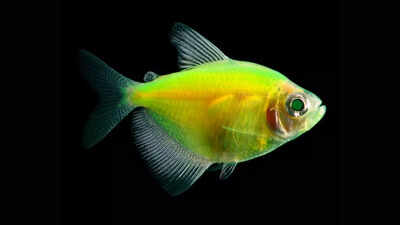Here’s how fish started glowing over 112 million years ago
Researchers Uncover the Evolutionary History of Biofluorescent Fish
Researchers have mapped biofluorescence across 459 species, revealing a diverse spectrum of colors. By analyzing every known instance of glowing bony fish and adding 48 new species to the list, the team discovered that biofluorescence initially appeared in ancient eels and has since evolved independently over 100 times. According to earth.com, the study published in PlosOne sheds light on the fascinating history and variety of biofluorescence in fish, transforming our understanding of life beneath the waves.

Glowing fish: Research reveals the incredible diversity of biofluorescence.
Biofluorescent fish have been radiant underwater for at least 112 million years. These fish absorb blue light and re-emit it in the form of green, yellow, orange, or red when exposed to it. This swirl of color often goes unnoticed because humans typically experience light during the day and under specific lighting conditions.
Coral Reefs and the Accelerated Evolution of Biofluorescent Fish
Following the mass extinction event 66 million years ago, as reefs began to recover, biofluorescent species rapidly diversified, taking advantage of new habitats and ecological niches. Coral reefs now appear to accelerate the evolution of biofluorescence in fish, with reef-dwelling species acquiring this trait about ten times faster than those in open water.
Research using museum specimens under special lights revealed remarkable diversity, with some families displaying at least six distinct peaks of fluorescence. This far surpasses previous documentation and highlights the vibrant complexity of life on coral reefs.
Methods for Fluorescence Imaging of Marine Fishes
Fluorescence imaging was conducted using live or freshly frozen specimens placed in a photographic tank. Imaging was performed before freezing, as fluorescence remains stable over time when specimens are promptly frozen. The process was carried out in a dark room using DSLR and mirrorless cameras with macro lenses, blue excitation filters, and long-pass emission filters to capture only emitted fluorescence. Different LP filters (514 nm and 561 nm) were used to isolate specific fluorescence wavelengths, with full imaging details provided in the supplementary material.
Future Research Directions
Researchers observed significant variation in fluorescence emission spectra not only among families and genera but even within individual fish. This diversity suggests the presence of a complex and potentially species-specific signaling system based on fluorescent patterns. Such variation could be valuable in taxonomic research, aiding in species identification and revealing hidden diversity.
To better understand this phenomenon, further studies are needed to:
- Explore the visual capabilities of more fluorescent species.
- Isolate the molecules responsible for biofluorescence.
- Investigate the ecological and evolutionary roles of biofluorescence.
Newer articles
-
 Suchitra Krishnamoorthi faces backlash for claiming Air India crash survivor was ‘LYING’; Deletes post and issues apology
Suchitra Krishnamoorthi faces backlash for claiming Air India crash survivor was ‘LYING’; Deletes post and issues apology
-
 Mahbub Anam replaces Faruque Ahmed as new BPL chairman
Mahbub Anam replaces Faruque Ahmed as new BPL chairman
-
 Pope retains No.3 spot; Carse set for home 'debut'
Pope retains No.3 spot; Carse set for home 'debut'
-
 'Would be remarkable to choose someone else if their last knock was a 170'
'Would be remarkable to choose someone else if their last knock was a 170'
-
 India vs England: Can Bazball outplay India's new era? Key battles and what to expect
India vs England: Can Bazball outplay India's new era? Key battles and what to expect
-
 Will Nysa Devgan enter Bollywood like Raveena Tandon's daughter Rasha Thadani? Kajol reveals the truth
Will Nysa Devgan enter Bollywood like Raveena Tandon's daughter Rasha Thadani? Kajol reveals the truth
-
 Ajinkya Rahane opts against Karun Nair in his India XI for first Test; explains why
Ajinkya Rahane opts against Karun Nair in his India XI for first Test; explains why
-
 5 smart tricks to instantly influence anyone (without being pushy), as per psychology
5 smart tricks to instantly influence anyone (without being pushy), as per psychology
-
 Still swooning over Ahn Hyo Seop and Kim Sejeong in ‘Business Proposal’? Here are 3 new K-Dramas to obsess over next!
Still swooning over Ahn Hyo Seop and Kim Sejeong in ‘Business Proposal’? Here are 3 new K-Dramas to obsess over next!
-
 Ngarava, Curran and Raza to miss Test series against South Africa
Ngarava, Curran and Raza to miss Test series against South Africa